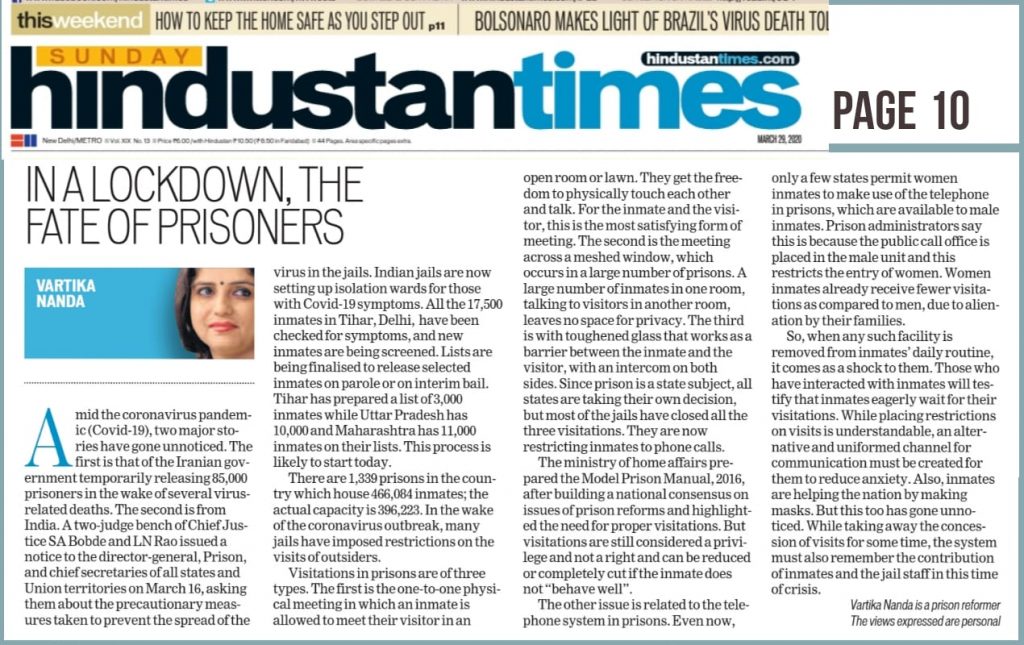Hindustan Times: Editorial page : March 29, 2020
While placing restrictions on jail visits is understandable, an alternative and uniformed channel for communication must be created for inmates to reduce their anxiety.

Amid the coronavirus pandemic (Covid-19), two major stories have gone unnoticed. The first is that of the Iranian government temporarily releasing 85,000 prisoners in the wake of several virus-related deaths. The second is from India. A two-judge bench of Chief Justice SA Bobde and LN Rao issued a notice to the director-general, Prison, and chief secretaries of all states and Union territories on March 16, asking them about the precautionary measures taken to prevent the spread of the virus in the jails. Indian jails are now setting up isolation wards for those with Covid-19 symptoms. All the 17,500 inmates in Tihar, Delhi, have been checked for symptoms, and new inmates are being screened. Lists are being finalised to release selected inmates on parole or on interim bail. Tihar has prepared a list of 3,000 inmates while Uttar Pradesh has 10,000 and Maharashtra has 11,000 inmates on their lists. This process is likely to start today.
There are 1,339 prisons in the country which house 466,084 inmates; the actual capacity is 396,223. In the wake of the coronavirus outbreak, many jails have imposed restrictions on the visits of outsiders.
Visitations in prisons are of three types. The first is the one-to-one physical meeting in which an inmate is allowed to meet their visitor in an open room or lawn. They get the freedom to physically touch each other and talk. For the inmate and the visitor, this is the most satisfying form of meeting. The second is the meeting across a meshed window, which occurs in a large number of prisons. A large number of inmates in one room, talking to visitors in another room, leaves no space for privacy. The third is with toughened glass that works as a barrier between the inmate and the visitor, with an intercom on both sides. Since prison is a state subject, all states are taking their own decision, but most of the jails have closed all the three visitations. They are now restricting inmates to phone calls.
The ministry of home affairs prepared the Model Prison Manual, 2016, after building a national consensus on issues of prison reforms and highlighted the need for proper visitations. But visitations are still considered a privilege and not a right and can be reduced or completely cut if the inmate does not “behave well”.
The other issue is related to the telephone system in prisons. Even now, only a few states permit women inmates to make use of the telephone in prisons, which are available to male inmates. Prison administrators say this is because the public call office is placed in the male unit and this restricts the entry of women. Women inmates already receive fewer visitations as compared to men, due to alienation by their families.
So, when any such facility is removed from inmates’ daily routine, it comes as a shock to them. Those who have interacted with inmates will testify that inmates eagerly wait for their visitations. While placing restrictions on visits is understandable, an alternative and uniformed channel for communication must be created for them to reduce anxiety. Also, inmates are helping the nation by making masks. But this too has gone unnoticed. While taking away the concession of visits for some time, the system must also remember the contribution of inmates and the jail staff in this time of crisis.
Courtesy: Hindustan Times
The steps taken by the jails are ingenious and heartening. As Nelson Mandela said, to deny people their human rights is to challenge their very humanity. So this is definitely a great stand taken.
The article has another positive note, recognizing the efforts of the inmates in making masks, which went unnoticed until now.
Dr Vartika Nanda and her team, through the Tinka Tinka movement, have always given the insights of the prisons, and have successfully worked in making the lives of the inmates better and have given them a platform to find and display their talents from time to time. As a citizen, I hope the issues of the women inmates are also taken care after this article.
To be able to think about the inmates compassionately from time to time has been one of Dr. Vartika Nanda’s most influential trait, with finding the positives from them. Sad that their efforts of making masks had gone unnoticed until now. Even Mother Teresa had described the fight for human rights as, “human rights are not a previlege conferred by government, they are every human being’s entitlement by virtue of his humanity”. After this article, hoping that the issues of women inmates are taken care by the authorities.
#vartikananda #tinkatinka #humanrights #prisonreforms
Tinka Tinka foundation is the first of its kind that work for the prisoner welfare and reform. Being the organisers of this Tinka Tinka foundation Dr. Vartika Nanda have taken several steps to make inmates life better across the country. Putting forward the idea of encouraging inmates towards education, culture, art, literature and media.
Congratulations ma’am for the success you have achieved . This is the result of your tremendous work and determination towards inmates welfare. Your efforts have changed the perspective of society towards them. This initiative address things right off the bat and become the bridge between the prison world and us.
#tinkatinka #vartikananda
#prisonreform #jailmovement
Thank you for the auspicious writeup. It in fact was a amusement account it. Look advanced to more added agreeable from you! However, how could we communicate?
Very interesting info !Perfect just what I was searching for!
Rattling informative and good structure of content, now that’s user genial (:.